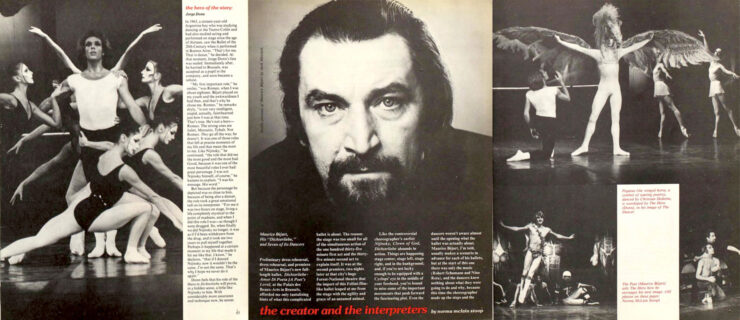Teacher's Wisdom: Susan Rethorst
Just as Susan Rethorst’s dances bristle with a quiet, alert curiosity, so does her teaching. “I don’t use the word ‘about,’” she told the small group of students at her choreographic workshop last December, assuring them that their work didn’t need to be “about” anything in particular. Rethorst sees dancemaking not as an expression of neatly formed ideas but as a means of discovering “things that you didn’t know you knew.”
Based in New York City since 1975, and splitting her time between NYC and Amsterdam since 1995, Rethorst has presented work extensively throughout the U.S. and Europe. She is the recipient of two Bessie Awards and a 2010 Alpert Award in the Arts. A renowned choreography teacher, she has helped establish post-grad programs in Amsterdam, Salzberg, Cork, and Copenhagen.
DM’s Siobhan Burke watched Rethorst’s winter workshop at St. Mark’s Church, part of the Movement Research Fall Festival, and caught up with her afterward.
Learning to choreograph is so much about finding your own voice. Can you teach someone to have a voice?
Anyone’s voice has to be unearthed. You can’t hand that to somebody. But you can help to excavate it from myths of making, from received definitions. It seems that choreography students are walking around with a lot of things that grate against their gut instincts. I try to empower people to trust their voice, which is there anyway—to liberate them into what they already know.
I also try to get people involved in the pleasure of making—a kind of deep pleasure that’s also of the intellect, of the whole person, that actually goes hand in hand with rigor. I read once that good art comes more from the play instinct than the work instinct, and I think that’s true. Play is this very profound thing that kids do. Their curiosity about the nature of things, the world and their place in it—that’s a profound investigation.
By any and all means I get people working and showing and making, until it’s just not a big deal. When they’re stuck, I say, “Go for quantity, forget quality,” just to get the motor going. Then you can move on to more interesting questions and away from “How do I start? What’s the right move?”
What makes starting points so paralyzing?
One thing is this sentence I hate: “If you don’t have something to say, you shouldn’t be in this class.” You become paralyzed with the stated importance of the thing. I also think that in the U.S. there’s a nervousness about art being elitist and self-indulgent. So that in order to do it, you have to prove you’re not a bad person, and the way to do that is to make it a moral education or social contribution. People don’t ask that of every profession, but somehow art has to prove its validity every time.
So how do you help your students get started?
I relieve them of that responsibility, because I just say, “Do this.” They have a task, and before they know it, they’ve started making. I say often that nobody is exempt from hesitations and self-doubt, and it doesn’t go away. But you develop strategies. My personal strategy is to have a deadline, or rent space that I have to pay for, or schedule rehearsals with people so I have to show up. That gets me going, and once I’m involved, I’m fine.
That reminds me of your essay
Dailiness. What does “dailiness” mean? I don’t know if I talked in that article about Judith Dunn, but she was a member of Judson Dance Theater and my teacher at Bennington in the 1970s. My senior year she did a tutorial called Dance A Day, where we made a dance every day. She didn’t give us any studio time or starting points or themes. You just had to show up and show your dance. It was terrifying. But I realized that making is something you just put into your life and do all the time. You don’t have to wait for a bolt of inspiration. By making work, I saw what I was interested in. And I saw that dancemaking engenders knowledge—it sheds light on and deepens the things you’re thinking about, brings in other facets that you couldn’t have anticipated.
You began your workshop with a simple game. Everyone chose a few things from a pile of objects and, with a partner, took turns arranging the objects on the floor. Why this exercise?
I see the game (which Simone Forti taught me to illustrate something else) as a metaphor for allowance. People never hesitate. They pick the objects they want. You know what you want. You’re attracted to it. You go for it. And you have to have that in your dancemaking. It’s easier during the game because it’s just a bunch of junk. I’m not asking, “What do you want to say with your dances?” I’m asking them to choose a bright shiny object. Given that allowance, things start to happen.
Is teaching in Europe different from teaching in the U.S?
Very different. In Vienna, Amsterdam, Berlin, Brussels, where I’ve been most involved, the language around dancemaking has a lot to do with “research”—and “transparency,” meaning that your research question is visible in your finished work. Reading a lot of theory and philosophy is often considered as important as studio time.
What do you want students to take away from your classes?
Hopefully they see that where their interests take them are valid places to go. I want to help them get on the other side of fear and find excitement, on the other side of beating themselves up and find that sense of profound play. If people do that, I’m happy.
Susan Rethorst (left) talks to a student about sequencing choreography at her Movement Research workshop last winter. Photo by Sarah Keough




